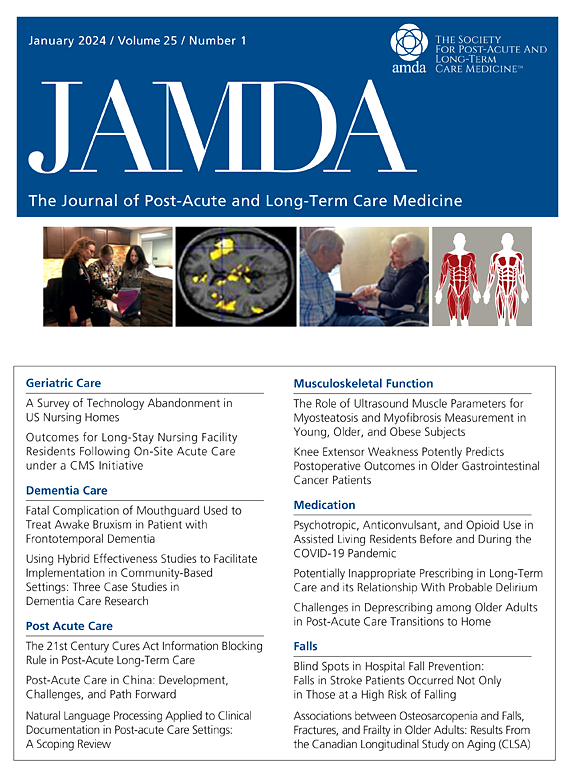Patterns of Transient and Terminal Transitions in Activities of Daily Living Performance Levels among Long-Term Care Residents: A Multistate Markov’s Model Analysis of Population-Based Longitudinal Data in Canada
IF 4.2
2区 医学
Q2 GERIATRICS & GERONTOLOGY
Journal of the American Medical Directors Association
Pub Date : 2025-04-09
DOI:10.1016/j.jamda.2025.105565
引用次数: 0
Abstract
Objective
We examined how long-term care (LTC) home residents transition between different activities of daily living (ADL) performance levels, and to eventual terminal clinical outcomes.
Design
We conducted a longitudinal retrospective analysis of population-based data among institutionalized older adults within 3 Canadian provinces.
Setting and Participants
LTC home residents within 3 Canadian provinces of Alberta, British Columbia, and Ontario placed between January 2010 and December 2020.
Methods
We fit a Markov-chain multistate transition model to the data to obtain transition probabilities, sojourn times, as well as the adjusted odds of each transition.
Results
Three distinct transitions were commonly experienced by residents from this analysis. Most LTC residents stayed unchanged in their ADL performance level between 90-day assessments, a substantial proportion transitioned to worse performance level, and only a small proportion improved to a better performance level. Residents spent on average between 21 and 29 months on admission before finally transitioning out of the setting to 1 of 4 terminal states that include mortality, hospitalization, home, or other setting discharges. Within 5 years of admission, between 63% and 72% died, 18% to 19% were hospitalized, and 2% to 4% were discharged back home. The odds of transitioning to different states were strongly affected by factors such as Index of Social Engagement, Cognitive Performance Scale, Changes in Health, End Stage Disease, and Signs and Symptoms score, age, as well as province where the LTC home is located, but varied depending on the admission ADL status.
Conclusions and Implications
Evidence from this study shows that it does not always have to be one way out for LTC residents. LTC home administrators could use the findings to identify residents who could be provided the right intervention to facilitate ADL performance improvement and prevent further decline.
求助全文
约1分钟内获得全文
求助全文
来源期刊
CiteScore
11.10
自引率
6.60%
发文量
472
审稿时长
44 days
期刊介绍:
JAMDA, the official journal of AMDA - The Society for Post-Acute and Long-Term Care Medicine, is a leading peer-reviewed publication that offers practical information and research geared towards healthcare professionals in the post-acute and long-term care fields. It is also a valuable resource for policy-makers, organizational leaders, educators, and advocates.
The journal provides essential information for various healthcare professionals such as medical directors, attending physicians, nurses, consultant pharmacists, geriatric psychiatrists, nurse practitioners, physician assistants, physical and occupational therapists, social workers, and others involved in providing, overseeing, and promoting quality

 求助内容:
求助内容: 应助结果提醒方式:
应助结果提醒方式:


